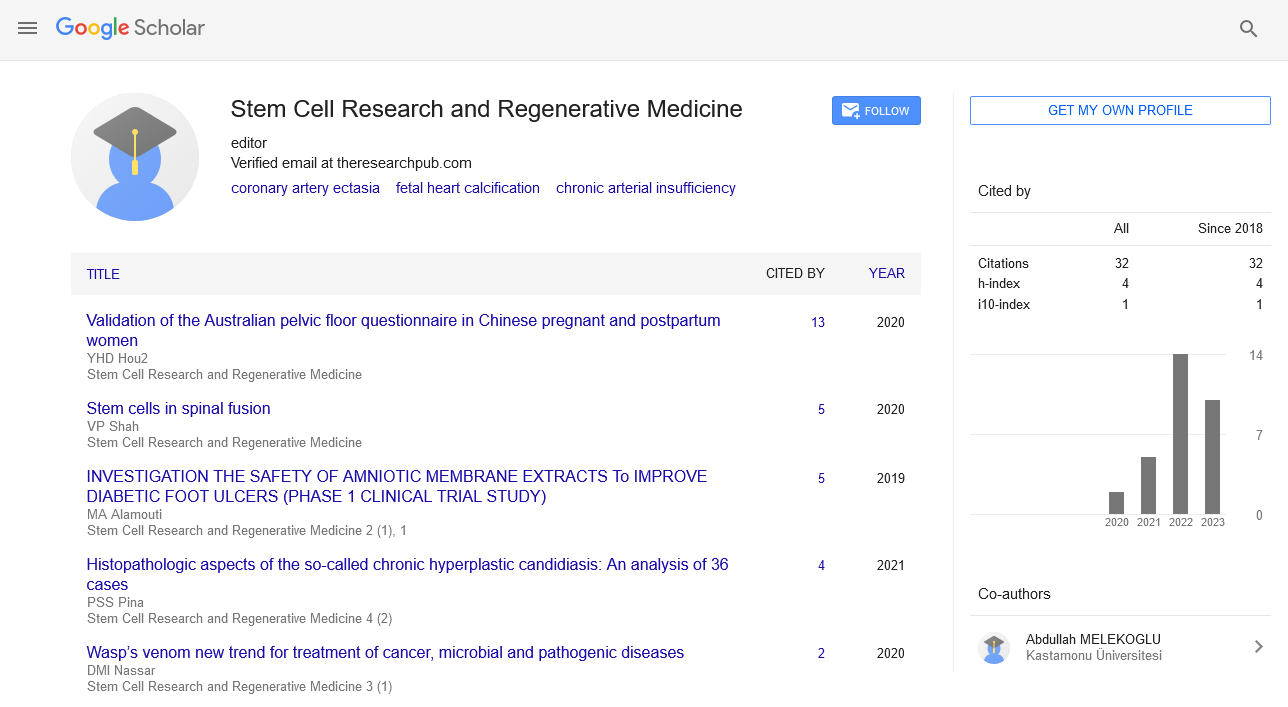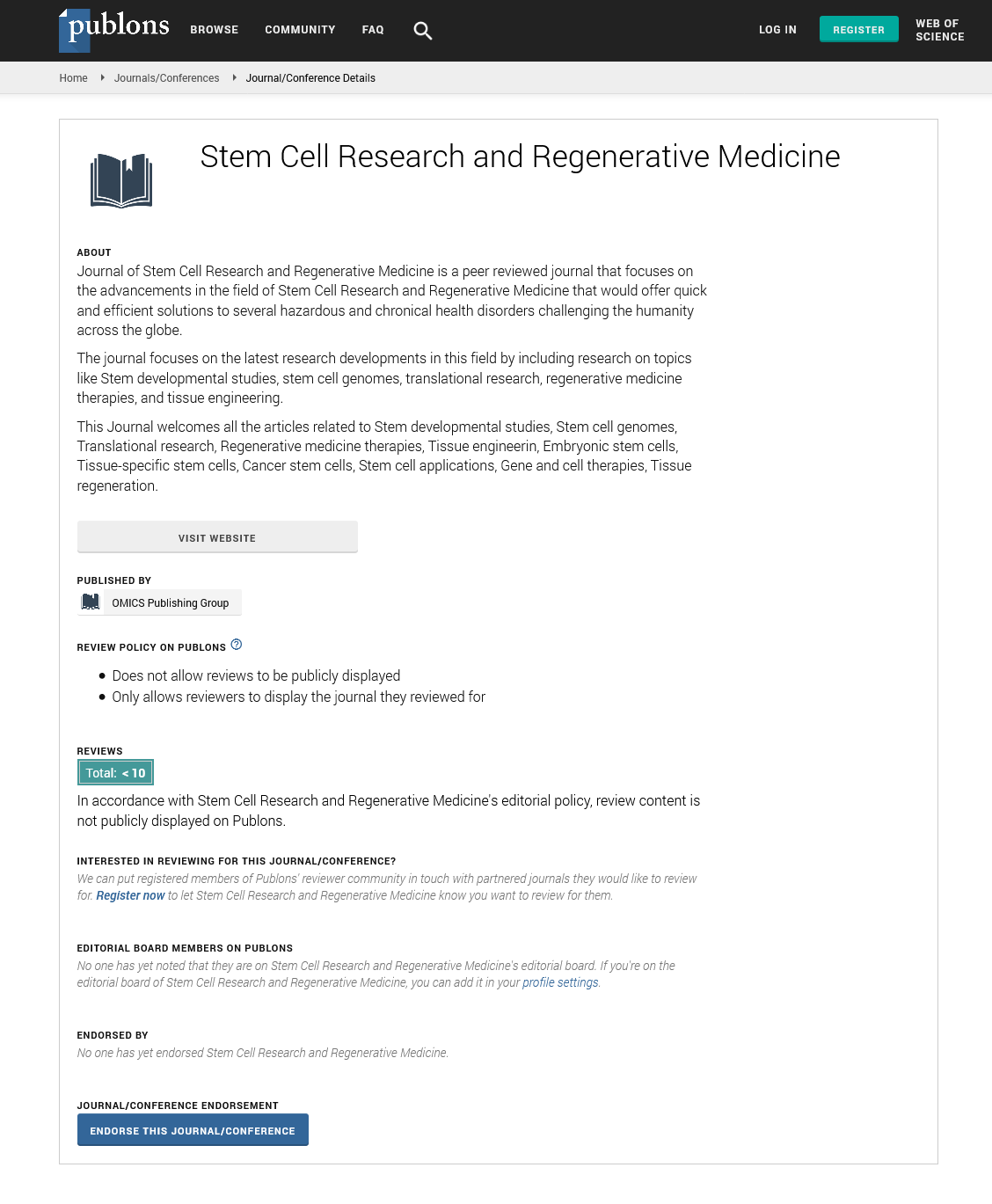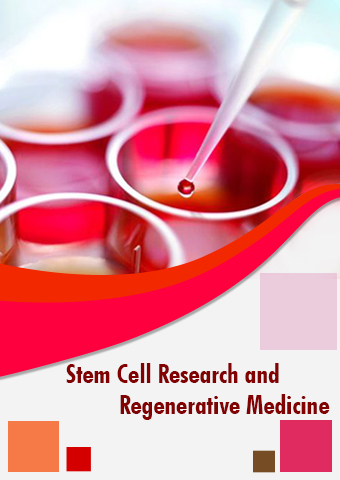Perspective - Stem Cell Research and Regenerative Medicine (2024) Volume 7, Issue 6
The Extracellular Matrix: A Crucial Architect in Cell Growth and Differentiation
- Corresponding Author:
- Salma Baig
Department of Biology, Auckland University of Technology, Auckland, New Zealand
E-mail: salma.baig@ med.asu.edu.eg
Received: 02-Dec-2024, Manuscript No. SRRM-24-153865; Editor assigned: 04-Dec-2024, Pre QC No. SRRM-24-153865 (PQ); Reviewed: 18-Dec-2024, QC No. SRRM-24-153865; Revised: 23-Dec-2024, Manuscript No. SRRM-24-153865 (R); Published: 31-Dec-2024, DOI: 10.37532/SRRM.2024.7(6).281-283
Introduction
The Extracellular Matrix (ECM) plays a fundamental role in supporting cell growth and differentiation, serving as both a structural scaffold and a dynamic biochemical environment that guides cellular behavior. The ECM is not merely a passive framework; it is a complex and dynamic network of proteins, glycoproteins, proteoglycans, and other macromolecules that create a highly specialized microenvironment for cells. This intricate matrix is central to regulating a wide range of biological processes, from embryonic development to wound healing and tissue regeneration. By providing physical support, biochemical cues, and mechanical signals, the ECM is an essential component that influences how cells grow, differentiate, migrate, and function.
Description
One of the primary functions of the ECM is to provide structural support to tissues and organs. The ECM forms a three-dimensional scaffold that maintains the integrity and architecture of tissues, enabling cells to adhere, form multicellular structures, and organize into complex patterns. This structural role is particularly evident in connective tissues, such as bone, cartilage, and tendons, where the ECM is composed of collagen fibers, elastin, and other proteins that confer tensile strength, elasticity, and resilience. The composition and organization of the ECM vary significantly between tissues, reflecting the unique mechanical demands and functional requirements of each tissue type. Cells within these tissues rely on the ECM to maintain their shape, polarity, and spatial orientation, which are critical for normal cellular function and tissue homeostasis.
Beyond its structural role, the ECM is a reservoir of signaling molecules that regulate cell behavior. Growth factors, cytokines, and chemokines are often sequestered within the ECM, creating localized gradients that guide cell proliferation, migration, and differentiation. These signaling molecules are released in response to specific triggers, such as injury or inflammation, providing a finely tuned mechanism for controlling cellular responses to changes in the environment. For example, during wound healing, the ECM releases growth factors like Transforming Growth Factor-Beta (TGF-β) and Fibroblast Growth Factor (FGF), which stimulate cell proliferation, migration, and the deposition of new ECM components. This dynamic regulation is essential for coordinating tissue repair and regeneration, highlighting the ECM’s role as an active participant in cellular communication.
The composition of the ECM is highly variable and adaptable, allowing it to influence cell fate decisions during development and differentiation. During embryogenesis, the ECM undergoes extensive remodeling to create distinct niches that support the formation of various tissues and organs. The stiffness, elasticity, and composition of the ECM can affect the differentiation pathways of stem cells, guiding them toward specific lineages. For instance, a soft ECM enriched with laminin and hyaluronic acid may promote the differentiation of stem cells into neural cells, while a stiffer matrix containing collagen and fibronectin favors osteogenic or myogenic differentiation. This mechanical and biochemical guidance is critical for the proper development of tissues and the establishment of functional organs. Understanding how the ECM modulates stem cell behavior is a major focus of regenerative medicine, as it holds the potential to enhance the development of engineered tissues and improve the outcomes of cell-based therapies.
Mechanotransduction, the process by which cells sense and respond to mechanical signals, is another crucial aspect of the ECM’s influence on cell behavior. Cells are equipped with specialized receptors, such as integrins, that connect to the ECM and transmit mechanical cues to the cell’s interior. These cues can influence gene expression, protein synthesis, and cytoskeletal organization, affecting cellular functions such as migration, proliferation, and differentiation. The ability of cells to sense the stiffness and topography of the ECM is a key factor in tissue morphogenesis and homeostasis. For example, in bone tissue, osteoblasts respond to mechanical strain by producing more ECM components and promoting mineralization, reinforcing the bone’s structure. In contrast, in soft tissues like the brain, neurons rely on a pliable ECM to support neurite outgrowth and synaptic connections. Dysregulation of mechanotransduction pathways can lead to various diseases, including fibrosis, cancer, and cardiovascular disorders, underscoring the importance of the ECM in maintaining cellular and tissue health.
In addition to its structural and biochemical roles, the ECM acts as a barrier and filter, regulating the movement of cells and molecules within tissues. This selective permeability is crucial for maintaining tissue compartmentalization and preventing the spread of pathogens or malignant cells. The ECM’s composition and density can restrict or facilitate cell migration, influencing processes like immune cell trafficking, cancer metastasis, and tissue repair. For instance, during immune responses, the ECM can be remodeled to allow immune cells to infiltrate inflamed tissues, while in cancer, changes in the ECM’s composition and stiffness can create pathways for tumor cells to invade surrounding tissues and metastasize to distant organs. The ECM’s role as a gatekeeper highlights its importance in regulating tissue dynamics and maintaining the balance between normal and pathological processes.
The ECM’s influence on cell behavior extends to its ability to undergo constant remodeling in response to physiological and pathological stimuli. Matrix remodeling is mediated by enzymes such as Matrix Metalloproteinases (MMPs) and Tissue Inhibitors of Metalloproteinases (TIMPs), which regulate the degradation and synthesis of ECM components. This dynamic turnover allows tissues to adapt to changing conditions, such as mechanical stress, injury, or disease. In wound healing, for example, the ECM is initially degraded to allow immune cells to access the site of injury, followed by the deposition of a provisional matrix that supports cell migration and tissue regeneration. Once the tissue is repaired, the ECM is remodeled to restore the normal architecture and function of the tissue. However, excessive or dysregulated ECM remodeling can contribute to pathological conditions, such as fibrosis, where excessive deposition of ECM components leads to tissue scarring and loss of function.
The ECM’s role in cancer progression has gained significant attention in recent years, as it is increasingly recognized as a key player in the tumor microenvironment. Tumors are not composed solely of cancer cells; they are surrounded by a modified ECM that supports tumor growth, invasion, and resistance to therapy. Cancer-Associated Fibroblasts (CAFs) are known to remodel the ECM, creating a stiffer and more fibrotic environment that promotes tumor cell migration and invasion. Additionally, the ECM can sequester growth factors and other signaling molecules that drive cancer cell proliferation and survival. The interactions between cancer cells and the ECM are complex and bidirectional, with cancer cells not only modifying the ECM but also responding to its signals in ways that enhance their malignancy. Targeting the ECM and its components is being explored as a therapeutic strategy to disrupt the tumor microenvironment and inhibit cancer progression.
In regenerative medicine and tissue engineering, the ECM is a critical component in the development of biomaterials and scaffolds designed to support cell growth and tissue regeneration. Researchers are harnessing the ECM’s properties to create synthetic and natural matrices that mimic the native ECM’s architecture and function. Decellularized ECM, derived from tissues and organs that have had their cellular components removed, retains the biochemical and structural cues of the original tissue and serves as an ideal scaffold for cell seeding and tissue regeneration. These ECM-based scaffolds have been used to engineer a variety of tissues, including skin, blood vessels, cartilage, and even whole organs. The ability of the ECM to provide a supportive environment for cells makes it an invaluable tool in regenerative medicine, offering the potential to create functional, patient-specific tissues for transplantation.
Understanding the ECM’s role in stem cell biology is another area of intense research, as the ECM is a crucial component of the stem cell nich the specialized microenvironment that maintains stem cell quiescence, self-renewal, and differentiation. The ECM in the stem cell niche provides mechanical and biochemical signals that regulate stem cell fate and function. Disruption of the ECM’s composition or structure can lead to stem cell dysfunction, contributing to aging, degenerative diseases, and cancer. In aging tissues, for example, changes in the ECM, such as increased stiffness and altered composition, can impair stem cell function and reduce the tissue’s regenerative capacity. By manipulating the ECM, it may be possible to rejuvenate aged stem cells and restore their regenerative potential, opening new avenues for anti-aging therapies and regenerative medicine.
The future of ECM research is likely to involve the development of advanced biomaterials that can replicate the complexity of the native ECM, enabling more effective cell-based therapies and tissue engineering approaches. Techniques such as 3D bioprinting, nanotechnology, and gene editing are being explored to create ECM-like structures that provide precise control over cell behavior. Additionally, a deeper understanding of how the ECM interacts with cells at the molecular level will provide insights into disease mechanisms and lead to novel therapeutic strategies for a wide range of conditions, from cancer to degenerative diseases and tissue injuries.
Conclusion
The extracellular matrix is not merely a passive backdrop for cellular activity; it is an active and dynamic participant in shaping cell behavior and tissue function. Its influence extends from providing structural support to regulating cellular communication, mechanotransduction, and tissue remodeling. The ECM’s ability to guide cell growth, differentiation, and migration makes it a critical player in development, homeostasis, and disease. As research continues to uncover the complexities of ECM biology, the potential for leveraging this knowledge to improve regenerative medicine, develop new therapies, and understand disease mechanisms grows. The extracellular matrix is, without a doubt, a cornerstone of cellular life, playing a pivotal role in maintaining the delicate balance between health and disease.


